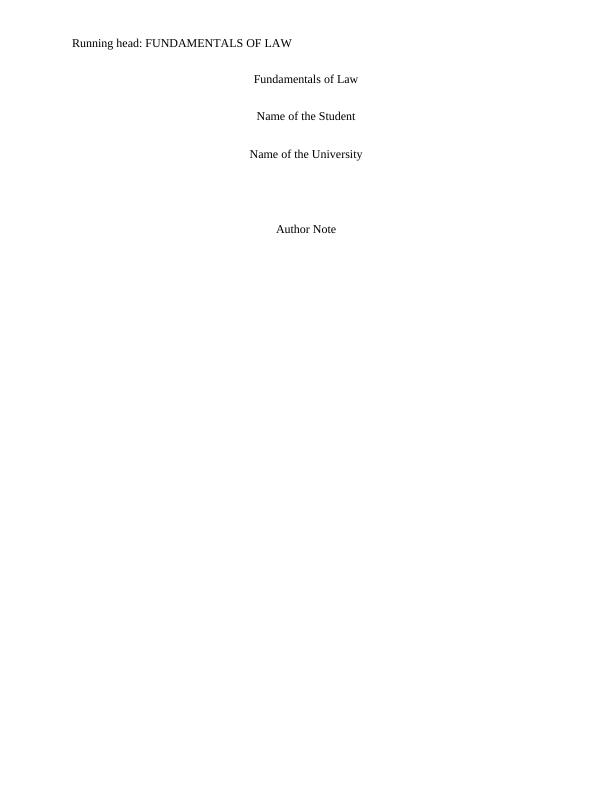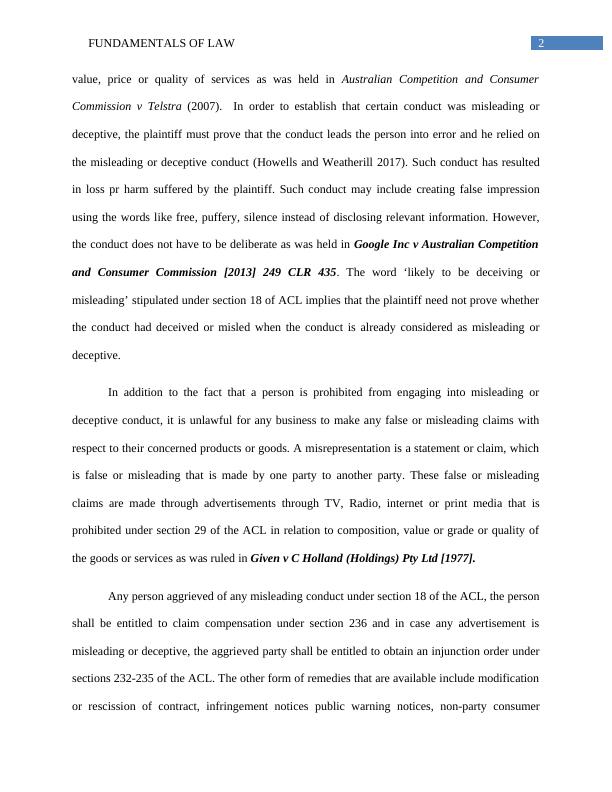Fundamentals of Law Assignment
Added on 2020-03-16
6 Pages1268 Words46 Views
Running head: FUNDAMENTALS OF LAWFundamentals of LawName of the StudentName of the UniversityAuthor Note

1FUNDAMENTALS OF LAWMost of the Australian Businesses uses television, radio, print media or internet as themeans to advertise their products and services (Ahmad 2016). The Australian Consumer Law(ACL) is a part of the Competition and Consumer Act 2010 (The Act), aims at ensuring fair-trading and safeguarding the rights of the consumers. IssueWhether misleading or deceptive claims can be made with respect to the advertisement of theproduct ‘Slendertone’. RuleThe Australian Consumer law (ACL) is applicable to persons which also includes businessforms and corporations. Some of the provisions of the ACL is also applicable to ‘consumers’ andsome other provisions apply generally in trade and commerce (Pearson 2017). In respect to theissue arising in the given scenario, the ACL guarantees protection against unacceptable conductsuch as deceptive or misleading contract under section 18 of the ACL and other specific forms ofconduct such as false representations under section 29 of the ACL. As the issue identified in thescenario is related to advertising and selling, there are two essential rules pertaining toadvertisement and selling under the Australian consumer law, which are as follows: A person is prohibited from engaging in a conduct that is likely to mislead or deceive;A person is prohibited from making any misleading or false statements or claims;However, these two rules often overlap with each other and a particular statement may be incontravention of both these rules. Section 18 of the ACL prevents a person from engaging intoconduct that is misleading or deceptive or any conduct that creates false impression regarding the

2FUNDAMENTALS OF LAWvalue, price or quality of services as was held in Australian Competition and ConsumerCommission v Telstra (2007). In order to establish that certain conduct was misleading ordeceptive, the plaintiff must prove that the conduct leads the person into error and he relied onthe misleading or deceptive conduct (Howells and Weatherill 2017). Such conduct has resultedin loss pr harm suffered by the plaintiff. Such conduct may include creating false impressionusing the words like free, puffery, silence instead of disclosing relevant information. However,the conduct does not have to be deliberate as was held in Google Inc v Australian Competitionand Consumer Commission [2013] 249 CLR 435. The word ‘likely to be deceiving ormisleading’ stipulated under section 18 of ACL implies that the plaintiff need not prove whetherthe conduct had deceived or misled when the conduct is already considered as misleading ordeceptive. In addition to the fact that a person is prohibited from engaging into misleading ordeceptive conduct, it is unlawful for any business to make any false or misleading claims withrespect to their concerned products or goods. A misrepresentation is a statement or claim, whichis false or misleading that is made by one party to another party. These false or misleadingclaims are made through advertisements through TV, Radio, internet or print media that isprohibited under section 29 of the ACL in relation to composition, value or grade or quality ofthe goods or services as was ruled in Given v C Holland (Holdings) Pty Ltd [1977].Any person aggrieved of any misleading conduct under section 18 of the ACL, the personshall be entitled to claim compensation under section 236 and in case any advertisement ismisleading or deceptive, the aggrieved party shall be entitled to obtain an injunction order undersections 232-235 of the ACL. The other form of remedies that are available include modificationor rescission of contract, infringement notices public warning notices, non-party consumer

End of preview
Want to access all the pages? Upload your documents or become a member.
Related Documents
Misleading and Deceptive Conduct in Business Lawslg...
|13
|2462
|451
Construction Law - ARBE1301 | Assignmentlg...
|11
|2396
|77
Business and Corporate Law Name of the University Authorlg...
|10
|1417
|291
Misleading and Deceptive Conduct in Advertising: A Case Studylg...
|9
|2141
|239
Assignment on Consumer Protection Law: Unethical Conductlg...
|9
|3917
|25
Australian Competition and Consumer Commissionlg...
|11
|2211
|18
